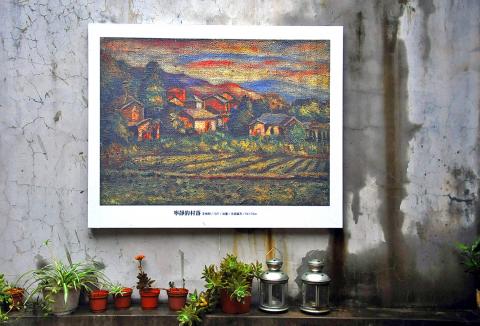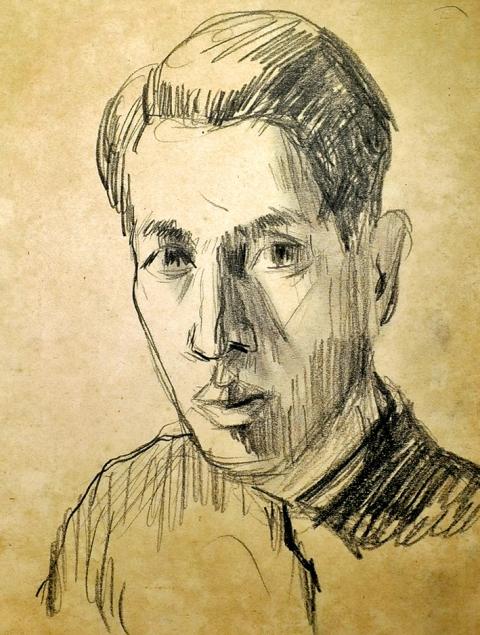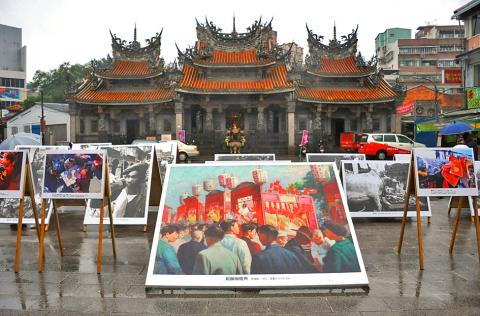Taiwan in Time: March 27 to April 3
What do photographer Chang Tsai (張才), artist Hung Jui-lin (洪瑞麟) and politician Chen Ping-chun (陳炳俊) have in common?
Chang, one of Taiwan’s first documentary photographers, took a series of photos of the divine pig ceremony in New Taipei City’s Sansia District (三峽) in the late 1940s. In the background was the Zushi Temple (祖師廟), which was then being renovated under the supervision of renowned painter and local politician Lee Mei-shu (李梅樹), who would later paint a scene of the ceremony in 1962.

Photo: Han Cheung, Taipei Times
Before he went into politics, Chen was Lee’s elementary school teacher at today’s Sansia Elementary School, and years later, as director of the Zushi Temple, he was instrumental in facilitating Lee’s renovation project.
Chen also founded the Chengfu Coal Mine (成福煤礦) in Sansia, which turns 100 this year. Hung, known for his vivid sketches of life in coal mines around Taiwan, studied at Tokyo University of the Arts with Lee, who made several portraits of Hung during that time.
All signs point to Lee, Sansia’s favorite son who would have celebrated his 114th birthday on March 12. Chang, Chen, Hung and many more artists and historic figures somehow connected to Lee are featured in the district’s Lee Mei-shu Month (李梅樹月) exhibition held all over town including the Chengfu mines, where Hung’s work is displayed along with other coal mine-related pieces. Through these connections, we get a sense of Lee’s life and legacy in Sansia.

Photo: Han Cheung, Taipei Times
LIFE OF A MASTER
Born in 1902 to a wealthy family, Lee’s father objected to his artistic aspirations, and he became a schoolteacher instead. However, Lee never stopped painting, and after his work made it into the Taiwan Art Exhibition (台灣美術展覽會) for the second year in a row, his elder brother defied family wishes and paid for Lee to study at Tokyo University of the Arts.
Chen and Lee would work together as Sansia politicians after World War II — Chen as town mayor and Lee as a Taipei County councilor — and both are recognized for their contributions to local development. Along with local physician Liu Chu-chuan (劉鉅篆), the three are known as the “three immortals (三仙) of Sansia.”

Photo: Han Cheung, Taipei Times
The exhibition’s magenta flags can be seen outside the Sansia Presbyterian Church, located near the entrance to Sansia Old Street. Built in 1952, it is featured in several of Lee’s paintings. The guest artist here is Tu Fu-an (杜福安), author of the comic book Love and Devotion: The Story of Mackay (愛與奉獻: 馬偕的故事).
Canadian Presbyterian missionary George Leslie Mackay visited Sansia in 1873, but was met with resistance by locals and was not able to establish a mission until 1876. Tu’s artwork mainly depicts the story of Mackay in Sansia, but also includes a scene telling the story of Lee’s role during the aftermath of the 228 Incident in 1947.
As government troops clashed with civilians around the country during the brutal suppression of the uprising, angry locals gathered in Sansia’s town hall, preparing to join the fight in Taipei.
As chairman of the Sansia town council, Lee reportedly insisted that the townspeople stay calm and refrain from acting rashly. As a result, Sansia was spared from government retaliation and nobody was hurt.
More magenta flags can be seen while walking down Sansia Old Street, which also turns 100 this year. At the end is the Zushi Temple, Lee’s masterpiece.
Built in 1767, the temple was revived after an earthquake in 1833 and again in 1899 after the Japanese burnt it after Taiwan became a colony in 1895.
When many locals returned safely after fighting for Japan during World War II, the townspeople wanted to renovate the temple again to thank the deities for protecting their sons.
Lee was originally reluctant to take on such a momentous task. But legend has it that one day, as he was walking past the temple, a sudden gust of wind blew a favorable divine lot to his feet. As a pious worshipper, he saw this as a sign and took on the job, which became a lifelong project, continuing even after he died in 1983.
It is said that he personally traveled with temple personnel to raise funds, and visited the site every day to oversee construction, meticulously designing the intricate wood, stone and copper carvings and decorations that earned the temple its nickname of “The Eastern Palace of Art.”
Lee never took a penny for his contributions, but he insisted that everything be done right, even if it meant slow progress. By the time of his death, he even had the third or fourth generations of the original craftsmen working for him. Even until this day, it is considered unfinished.
But that’s the way Lee wanted it. Referring to the construction of the St Peter’s Basilica in the Vatican, which took 120 years, Lee once said: “If we want to build a temple that is representative of our religion, 20-something years really is not that long.”
Taiwan in Time, a column about Taiwan’s history that is published every Sunday, spotlights important or interesting events around the nation that have anniversaries this week.

In the March 9 edition of the Taipei Times a piece by Ninon Godefroy ran with the headine “The quiet, gentle rhythm of Taiwan.” It started with the line “Taiwan is a small, humble place. There is no Eiffel Tower, no pyramids — no singular attraction that draws the world’s attention.” I laughed out loud at that. This was out of no disrespect for the author or the piece, which made some interesting analogies and good points about how both Din Tai Fung’s and Taiwan Semiconductor Manufacturing Co’s (TSMC, 台積電) meticulous attention to detail and quality are not quite up to

April 21 to April 27 Hsieh Er’s (謝娥) political fortunes were rising fast after she got out of jail and joined the Chinese Nationalist Party (KMT) in December 1945. Not only did she hold key positions in various committees, she was elected the only woman on the Taipei City Council and headed to Nanjing in 1946 as the sole Taiwanese female representative to the National Constituent Assembly. With the support of first lady Soong May-ling (宋美齡), she started the Taipei Women’s Association and Taiwan Provincial Women’s Association, where she

Chinese Nationalist Party (KMT) Chairman Eric Chu (朱立倫) hatched a bold plan to charge forward and seize the initiative when he held a protest in front of the Taipei City Prosecutors’ Office. Though risky, because illegal, its success would help tackle at least six problems facing both himself and the KMT. What he did not see coming was Taipei Mayor Chiang Wan-an (將萬安) tripping him up out of the gate. In spite of Chu being the most consequential and successful KMT chairman since the early 2010s — arguably saving the party from financial ruin and restoring its electoral viability —

It is one of the more remarkable facts of Taiwan history that it was never occupied or claimed by any of the numerous kingdoms of southern China — Han or otherwise — that lay just across the water from it. None of their brilliant ministers ever discovered that Taiwan was a “core interest” of the state whose annexation was “inevitable.” As Paul Kua notes in an excellent monograph laying out how the Portuguese gave Taiwan the name “Formosa,” the first Europeans to express an interest in occupying Taiwan were the Spanish. Tonio Andrade in his seminal work, How Taiwan Became Chinese,